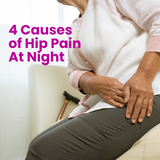4 Causes of Hip Pain at Night
No one wants to start their mornings dealing with hip pain that has kept them tossing and turning all night. Unfortunately, for those dealing with hip pain, especially at night, this is a common scenario. To make matters worse, recurring sleepless nights can lead to chronic sleep deprivation, creating heightened pain levels and disrupting your body’s ability to recover.
Although hip pain, when sleeping, affects as many as 1 in 5 people over 65, its causes and best prevention methods can be difficult to pinpoint.
To help you do just that, we’ll cover the 4 most common causes of hip pain at night and provide practical tips for management and prevention. Our goal is to help you start getting pain-free sleep every night so you can wake up feeling refreshed and ready to take on the day.
The Causes Behind Your Hip Pain
While there are a variety of causes that contribute to hip pain when sleeping, it’s more than likely that the cause of your pain is caused by one of the causes listed below.
1. Hip Arthritis
At number one, we have the most common cause of hip pain in older adults: hip arthritis! Affecting much of the world’s aging population, this condition involves the deterioration of cartilage in the hip joint, leading to increasing stiffness and discomfort.
Condition-Specific Symptoms Include:
- Pain during activities
- Reduced range of motion
- Clicking, cracking, or a popping sound when moving
- Weakness in the hip
2. Greater Trochanteric Pain Syndrome (aka Hip Bursitis)
A specific type of hip bursitis, Greater Trochanteric Pain Syndrome (GTPS) comes in second place in our list! As with hip arthritis, GTPS is found more commonly in older adults and affects women more than men. This condition is characterized by inflammation of the bursae and other surrounding areas around the hip joint, also known as the greater trochanter.
Condition-Specific Symptoms Include:
- Sharp, aching pain
- Lateral hip pain
- Pain during activities
- Pain that worsens with lying on the affected side
3. Sciatica and Sciatic Piriformis Syndrome (SPS)
In third place, we have two seemingly similar but distinct causes of hip pain: sciatica and SPS. For the purposes of this blog, we'll group them together as conditions involving the sciatic nerve. However, it's crucial to understand their differences when seeking appropriate treatment and prevention methods.
To differentiate between the two, consider the following factors:
- Pain Location:
- Sciatica:Pain typically originates in the lower back and radiates down the back of the affected leg, at times reaching the foot.
- SPS:Pain usually starts in the buttock region and may radiate along the back of the thigh but often stops above the knee.
- Triggering Factors:
- Sciatica: Worsens with activities like bending, lifting, or sneezing.
- SPS: Triggered by prolonged sitting or certain leg positions, especially crossing the legs.
Condition-Specific Symptoms Include:
- Inflammation
- Pain and weakness
- Numbness or tingling in the leg
- Difficulty moving or bending down
4. Overuse Injury and Muscle Strain
Lastly, we have repetitive stress injuries—soft tissue injuries that result from gradual wear and tear or insufficient recovery time.
While an overuse hip injury can include strains, not all strains are caused by overuse; they may also result from improper warm-up or incorrect movement.
Condition-Specific Symptoms Include:
- Pain and stiffness
- Bruising and swelling
- Reduced motion
- Weakness and difficulty walking
Hip Pain Management
Now that you have a better understanding of the causes of your hip pain let's explore 4 recommended strategies to manage any pain and swelling. First, we'll look at how to relieve hip pain while sleeping.
1. Optimize Your Sleeping Position
If you're like most people, you probably stick to one or two favorite sleeping positions each night. Unfortunately, it might be time to reconsider—stomach sleepers, we’re looking at you.
Choosing a sleep position isn't just about comfort; it's also important to consider your body's alignment to avoid added stress and relieve hip pain.
Sleeping on your Back
Sleeping on your back is the best position to manage hip pain. This position helps evenly distribute your weight, taking pressure off your hip joints.
For increased hip support, place a pillow under your knees.
Sleeping on Your Side
If sleeping on your back is not an option, sleeping on your side can be a great alternative. To minimize hip pain, sleep on the side that does not have hip pain.
For the side sleepers, placing a pillow between your knees can help maintain proper hip alignment and reduce discomfort.
Sleeping on your Stomach
It's best to avoid sleeping on your stomach, as this position creates the most stress on your lower back, contributing to more hip pain at night.
However, if you can't sleep in any other position, try placing a thin pillow under your hips to reduce strain.
2. Hot and Cold Therapy
A common method of relieving hip pain involves the strategic use of hot and cold therapy. While both hot and cold therapy can be practiced in a conjoined routine, they each have unique benefits.
Heat Therapy
Heat therapy relieves muscle stiffness, improves blood flow, and promotes healing. You can use a heating pad, take a warm bath, or use warm towels.
It’s best for chronic hip pain, muscle tension, and stiffness. However, avoid using it immediately after an acute injury, as this can increase swelling. Instead, use it in intervals of 15 - 20 minutes and repeat as needed throughout the day.
Cold Therapy
Cold therapy reduces swelling and inflammation and numbs pain. It’s ideal for acute hip injuries or pain to minimize swelling and pain within the first 72 hours.
You can use an ice pack, cold gel packs, or even a bag of frozen vegetables wrapped in a cloth. Use in intervals of 15 - 20 minutes and repeat every 1-2 hours as needed.
Alternating between heat and cold therapy can be beneficial for certain conditions like chronic hip pain or after the initial inflammation has reduced. Always start with cold therapy and alternate between 15 to 20 minutes of cold and 15 to 20 minutes of heat.
3. LUMINAS Hip Pain Relief Patches
If you’re looking for hip pain management that’s free of side effects, medications, and all-natural, we’re your people! Our LUMINAS Relief patches are designed to effectively relieve pain and inflammation right at the source of the issue, offering a convenient and health-friendly solution for managing hip pain.
100% Chemical-Free: Our patches are charged with electrons that work naturally with the body to reduce pain and inflammation with zero side effects.
Long-Lasting Effect: Our patches provide the pain support you need for up to 24 hours, allowing you to get back to the important stuff without the worry of hip discomfort.
Get Your LUMINAS Hip Pain Patches Here
4. Physical Therapy
If you find that you struggle with severe hip pain and are unable to relieve it through home remedies, physical therapy may be your solution. While physical therapy may not be the most cost-effective option for all, it offers an individualized approach through a treatment plan that may more effectively help you determine and treat the underlying causes of your hip pain.
Reminder: Consult with a doctor and review your medical history before incorporating a pain reliever into your hip pain management routine. Pain relievers, such as oral NSAIDs, can have harmful side effects, especially for those with a chronic condition or an autoimmune condition.
Recommended Prevention Strategies for Hip Pain at Night
Addressing the root causes of hip pain is essential to prevent more severe issues. Here are three key practices to build a strong foundation and prevent hip pain at night:
1. Maintaining a Healthy Weight
As a common underlying cause of hip pain at night, staying within a weight range is undeniably crucial to keeping your hips healthy. Excess weight strains the hip, causing joint damage that may not have normally occurred.
While regular exercise is important for weight management, making dietary changes is a great place to start. Incorporating more Omega-3 fatty acids, found in foods like salmon and sardines, can help reduce inflammation and support hip joint health.
2. Regular Exercise
Regular exercise is crucial for maintaining strong and flexible hip joints and muscles, which helps reduce the risk of injury. Low-impact exercises, such as walking, swimming, and tai chi, are gentle on the joints and improve circulation!
Yoga and Pilates can also help enhance flexibility and strengthen the hip flexor muscles, with poses like Warrior II and Bridge Pose being particularly beneficial.
3. Proper Posture and Body Alignment
Maintaining good posture and proper body alignment reduces stress on the hip joints and helps prevent additional hip problems.
Stand with your feet hip-width apart and distribute your weight evenly. Avoid crossing your legs and knees, ensuring you keep your hips aligned. Using tools like walking sticks and taking regular breaks after long periods of activity can also help maintain proper alignment and reduce strain on your hips.
By recognizing and being able to differentiate between different causes of hip pain at night, you can safely and confidently decide the best course of action for treatment options. For extra support as you implement new practices, incorporate LUMINAS Hip Pain Relief patches in your routine for powerful, targeted pain relief.
Making big changes like the ones discussed aren’t easy, but taking small steps every day towards positive change will get you closer and closer to a pain-free life.
Experience Natural Hip Pain Relief - Shop LUMINAS Patches








